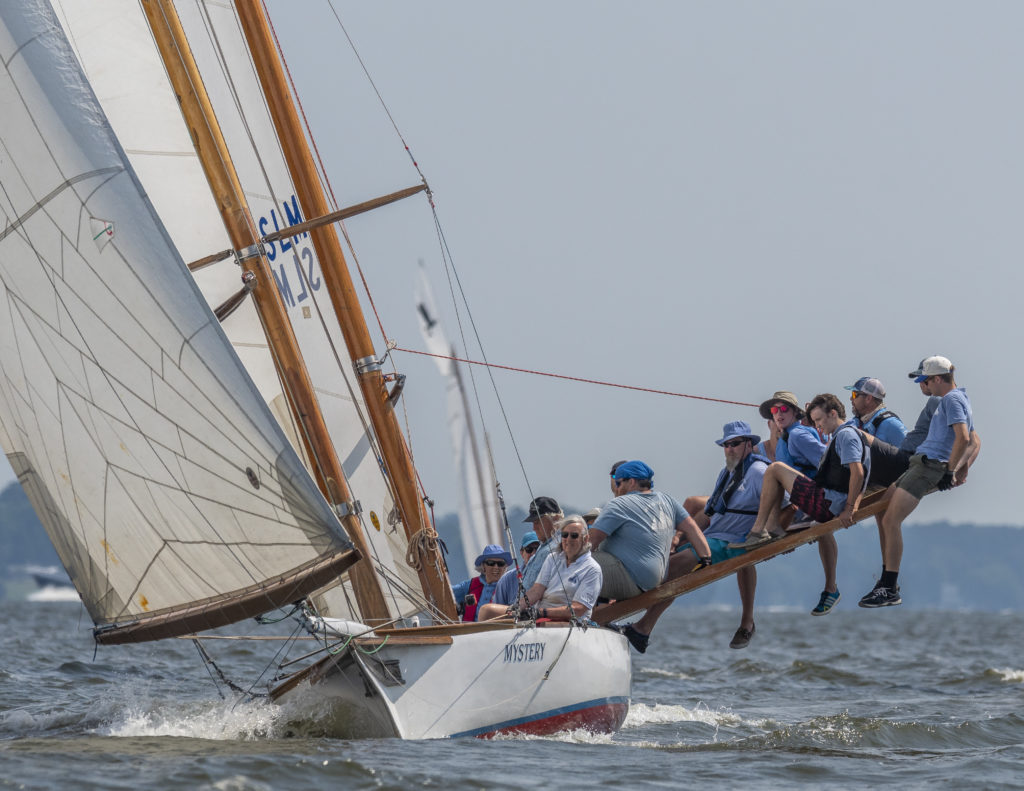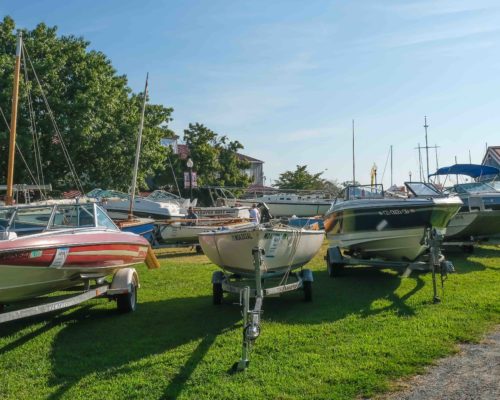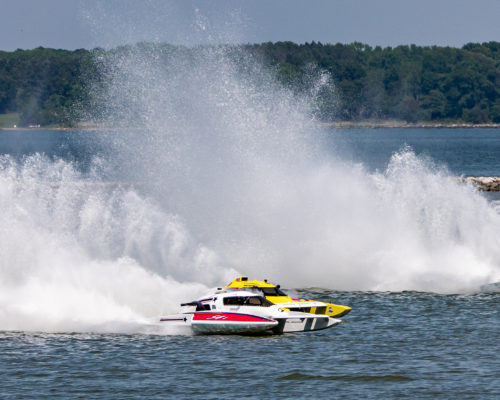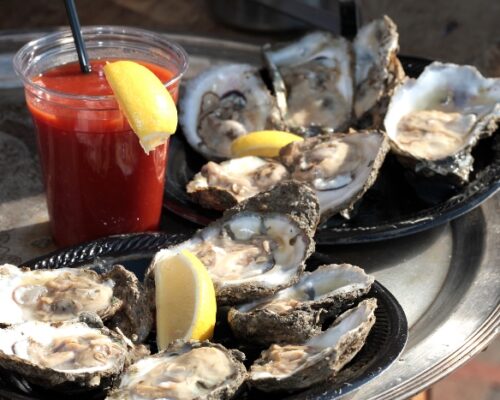Without her masts, she looks a bit like a beached narwhal: rounded white hull, long bowsprit pointed toward the cavernous boatshed’s mouth. It’s only when you come in that you see the gorgeously varnished new cypress and sassafras decks on Mystery. She looks damn good for an aging beauty. Mystery is celebrating her 90th year. It could be a watershed year for her and longtime owners, Francis and Evelyn Schauber (affectionately known as Franny and Suzy), because, like the boat, no one is getting any younger. “We have a geriatric crew,” Suzy says. “Three on board are over 70, including Fran and me.”
Log canoe racing is demanding, sometimes grueling (albeit exhilarating) and doesn’t get any easier as the years go by. “I’ve been to the doctor’s once and the hospital twice, racing,” says Ron Mullar, longtime Mystery crew, who turned 73 recently.
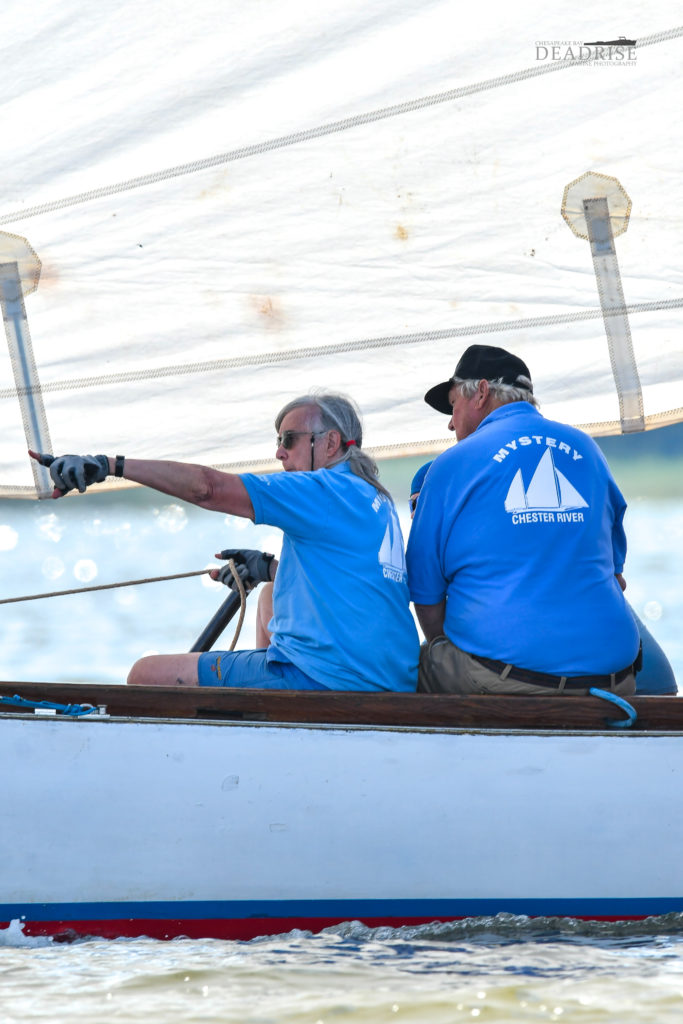
“This is Suzy and my’s last year,” Fran says as he heads toward the long workbench on one side of the shed. He pauses for a second, then adds with only the hint of a smile, “I’ve been saying that for the last ten years.”
Like many long-term relationships—both human and boat—this is a love story. It starts in 1966. Suzy was 17; Franny was 20. Suzy’s father was a big log canoe fan and often sailed the family’s Luders 33 to wherever the canoes were racing.
“I saw Fran sitting on the stern of Bojan, one of the chase boats,” Suzy remembers, grinning. And he saw her.
Franny was crewing on Mystery. The five-log, 34’8″ by 8’8″ Mystery—third largest canoe in the fleet—was built in Oxford by Harry and Price Sinclair in 1932. Commissioned by John D. Williams, who owned Jay Dee (which was built in 1931 but ineligible to compete for the Governor’s Cup due to her transom design), Mystery was designed to qualify. She did, but Williams repeatedly failed to win the cup, so he sold the boat in 1938. She changed hands several more times until John Whittum of Chestertown, Md., bought her in 1957.
Suzy liked watching, but she wanted to race. Besides, Fran was aboard. “I had watched for what felt like forever, and finally Kenley [Jenkins, who skippered] let me on board,” she remembers.
Like all aging wooden vessels, Mystery needed continual attention, especially after the beating she’d take on race weekends. But there was no question of handing her over to a yacht yard. “Fran and Dean Burt were in charge of fixing her,” Suzy says. “Fran would go to a small Amish sawmill in Ridgely, Md., and he’d get white oak and long leaf pine.” When Fran’s father sold his half of Chestertown Brick Co. in 1972, Fran had to find another livelihood, so the newlywed Schaubers bought that small Amish sawmill. From then on, he milled the wood for Mystery. “Fran should really, really be proud of Mystery,” Suzy says. “Because all of that wood, except the logs, were Fran’s work.”
In 1976, Whittum offered to sell the canoe to the young Schaubers for “a very attractive price,” paid in installments. The decking at that time was plywood and needed replacing, so Suzy, Jim Stevenson (who later owned Noddy), Michael Dickenson and Fran’s cousin, Denny Schauber, spent the summer rebuilding Mystery.
Keeping Mystery Racing
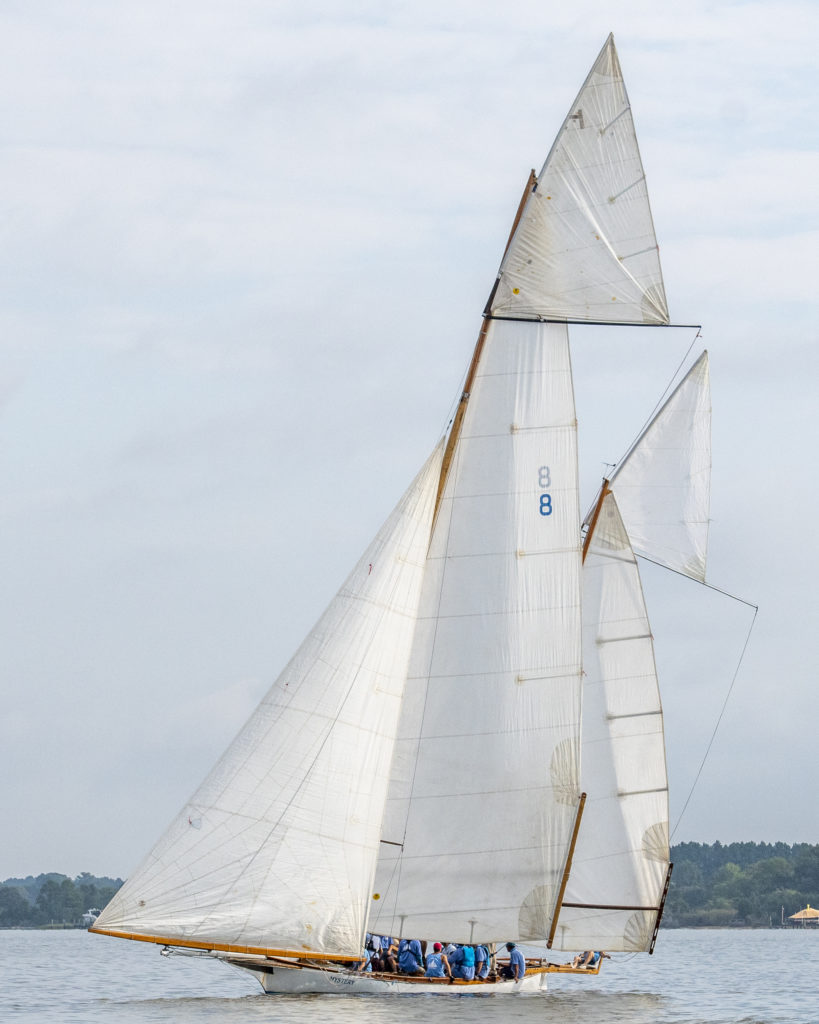
On this June day just prior to the first race of the 2022 season in St. Michaels, she is in race-prep—or rehab, depending on your outlook. The continual renewal of the old canoe is still a theme in their lives today, 46 years later, and those of their 14- to 15-member crew. Fran insists that he was done tinkering with her until crewmembers Kyle Leaverton and Mark Hergan went to work. “I wasn’t going to touch her, then they started doing the decks and now look what happens,” Fran says, nodding at the pair.
Chesapeake photographer and VP of Stevenson University Mark Hergan had admired Mystery through a camera lens for years. “His screen saver was a picture of Mystery before we ever met him,” Kyle says. Mark is a newer member of the crew, but some, like Ron Mullar, have been with the Schaubers for decades, even generations. Mitchell Grieb was 14 when he joined his dad on board; he’s now in his early 60s. Kyle, 34, was preceded by his mother, Donna Hardy. “I was 13, and one day my mom said, “You’re going to race with Franny and Suzy,” Kyle remembers.
Keeping Mystery racing continues to be collaborative. Ron is working on the 60′ foremast beside the workbench, while Kyle and Mark consult on the new halyards Mark brought with him. Meanwhile, Suzy, sitting on a crate, scoots along the hull as she lays down painter’s tape on either side of the blue boot stripe between white topsides and what she calls the “kick-ass red” bottom. As she works, she and Ron re-litigate a race that had a “We was robbed” outcome. “They remember the details of races 30 years ago,” Mark smiles, raising an eyebrow toward them as he pays out the new halyard.
For Fran, in addition to the easy collegiality of the team, there is the beauty of figuring out solutions to problems. He points to a racked mast that broke when a stay parted. “I designed a wooden strengthener to spread the load to stress points where shrouds are attached,” he says. The mention of stress points triggers a question from the gallery.
“What’s the wind gonna be?” Ron asks no one in particular.
“Eleven to thirteen,” Kyle replies.
“I don’t like wind,” Ron growls. “Eight knots is what I like.” They all agree. These boats like light wind, and so do most of their crews. Racing, especially on log canoes, is challenging. But it’s the pleasure, excitement, comradery and tradition that keeps everyone coming back for more. The only question for both human and boat is: When to call it quits?
“We’re ready to give it up,” Ron says, nodding toward Suzy. “But she’s not.” Suzy looks up, grins, then keeps on taping.
From Logs to Legacy
The fleet of Chesapeake Bay log canoes—those spectacularly over-canvassed, wooden (mostly) racing vessels—are almost all geriatric. Several of those that are still competing were built in the late 1800s and early 1900s. Others, including Mystery, are Depression-era babies. Descended, improbably, from single-log dugout canoes used for centuries by native tribes for fishing and transport, they’ve morphed considerably over time, growing from one to three and five logs bolted together, which enlarged the carrying capacity and reach.
Bigger boats called for spars carrying more and more sail, adding to their instability. Hiking boards loaded with moveable ballast in the form of crew, who scramble out and cling to the boards (and sometimes each other), counteract the propensity to capsize. Mostly (which is one of the real dangers in the sport). According to John C. North II, author of Tradition, Speed and Grace: Chesapeake Bay Sailing Log Canoes, The first log canoe race took place in 1859 in St. Michaels, while the vessels were still working boats. Now far from their working roots, Chesapeake log canoes — cinematically beautiful but extremely challenging racing boats — carry on a Bay tradition, and the competitive spirit of their crews is not only alive and well, but against all odds continues to thrive.

